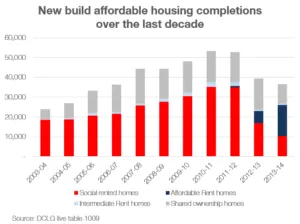2013/14: the worst year for social rented house building since WW2
Published: by John Bibby
A number of notable things happen around the end of October: Diwali, Halloween, the clocks go back and the government publishes its annual update on affordable housing supply.
The first couple of those may provide a good excuse for a party, but this year’s affordable housing statistical release is nothing to celebrate. It is, without overstatement, a disaster.
There are two main stories that the statistics tell.
The first is that the overall level of affordable completions has fallen for the third year in a row, down by over a third since 2010. At a time when we need output of all types of housing to roughly double, this is itself very bad news.
Probably even more alarming, however, is what’s revealed when we look at the detail of the types of ‘affordable homes’ that were built.
This is because not all ‘affordable homes’ are created equal. Under the broad umbrella comes a wide variety of different intermediate and social homes, including:
- Shared ownership homes (part-rent, part-buy homes)
- Intermediate rent homes (short-term homes charged at up to 80% of market rents)
- ‘Affordable Rent’ homes (long-term homes charged at up to 80% of market rents)
- Social rented homes (long-term homes charged at social rents – typically about 50% of market rents)
While the number of ‘affordable homes’ built every year has fallen by a third since the most recent peak in 2010, the number of social rented homes has fallen by over two thirds – down from over 35,000 to just 10,000.
This makes 2013/14 the single worst year for new social rented house building since the end of the Second World War.
In 1946, during demobilisation in the immediate wake of the war, we built twice as many social homes as last year.
The level of output is so low that through Right to Buy sales alone 5,000 more units were lost from the social rented stock last year than were added through new building.
Driving this shift in the type of affordable home that is being built is the growth of Affordable Rent. Only created as a type of housing in 2011, Affordable Rent is now the default form of new government-supported rented home. That default status is now feeding through in terms of units being built. Last year Affordable Rent homes accounted for 43% (15,840) of total affordable completions.
By being charged at up to 80% of the market, Affordable Rent homes are typically substantially more expensive than social rented homes. In London, this has meant monthly rents on new Affordable Rent family homes purportedly as high as £2,800 a month.
Shelter has argued strongly for an expansion in the number of intermediate homes that are being built – homes to rent or buy that cost less than private sector rents, but above social rents – for people on low to middle incomes. This expansion could include growth in the number of homes that are charged at intermediate rents, like Affordable Rent. But it must be in addition to, not in place of, new social rented homes.
Failing to build the social homes will not only deprive the millions of people on council waiting lists of a truly affordable place to call home: it threatens to undermine the new Affordable Rent programme itself. If social rented house building continues at historically low 2013/14 levels, families on low incomes on the waiting list will be placed in Affordable Rent homes that they will likely never be able to afford. Housing benefit will pick up the difference and the welfare bill will grow. Welfare dependency will increase.
Although successive governments have failed to substantially increase levels of social rented house building, this isn’t a problem without a solution. In Building the homes we need, the report we published earlier in the year with KPMG, we set out the policy changes needed to increase house building of all types, including social rented homes. We need to make sure that politicians on all sides commit to those policies so that next October we have more cause for optimism.

